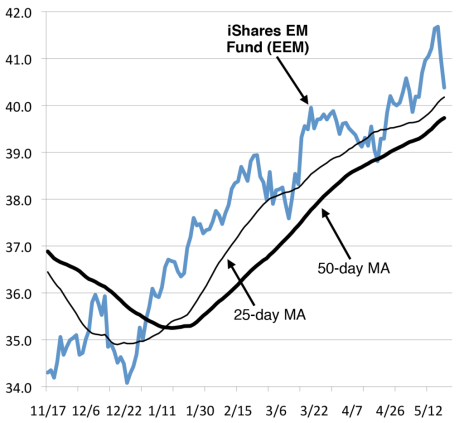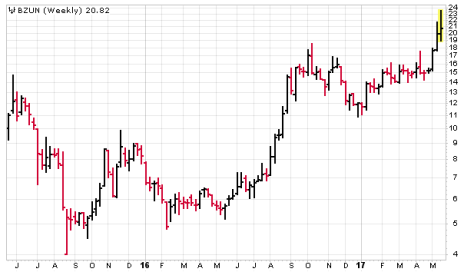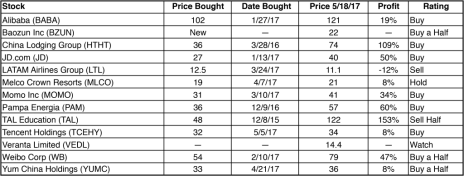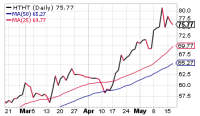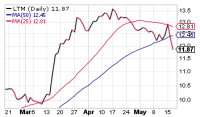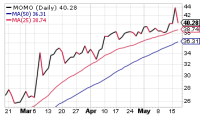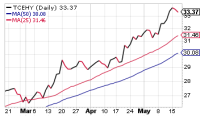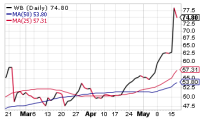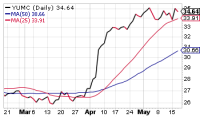Investors’ jitters about the dog fight in Washington, D.C. caused a sharp market correction this week that included emerging market stocks. Our portfolio also sustained a little damage, but, so far at least, it’s under control. The major uptrend in emerging markets has been dulled, but not blunted. In this issue, I look at the performance of emerging vs. developed market stocks. I also bring back a stock from last year that will give us a different take on Chinese retail.
Cabot Emerging Markets Investor 633
[premium_html_toc post_id="134155"]
Cabot Emerging Markets Timer
The Emerging Markets Timer is our disciplined method for staying on the right side of the emerging markets. The Timer is bullish when the index is above the lower of its two moving averages and that moving average is trending up.
Political uncertainty (in the U.S. and now Brazil) has brought out the sellers, but our Emerging Markets Timer is still positive, telling us the intermediate-term trend remains up. Like many growth-oriented stocks and indexes, the iShares EM Fund (EEM) had a great month-long run from mid-April to mid-May but is now pulling back toward support.
What happens from here will be crucial. Further selling could produce a sell signal, but we always go with the evidence at hand, and to this point, the dip in EEM is acceptable, as it remains above its lower (50-day) moving average. Bottom line: We remain bullish but have our eyes open.
Pep Talk
Congratulations! As a subscriber to Cabot Emerging Markets Investor, you’re right on top of one of the hottest trends in equity investing. That’s because emerging market stocks are, as my mother used to say, hotter than a two-dollar pistol.
A quick look at the year-to-date numbers supplied by MSCI will make it clear. Since the year began, U.S. stocks have risen 7.5% and the MSCI World index has grown by 8.6%. And in that same time, the MSCI Emerging Markets index is up 17.2%. The U.S., the global market and emerging markets are all in bull territory, but EM stocks are tearing
it up.
Looking at individual emerging market countries also yields fascinating results. Thus far in 2017, only two countries are in negative territory, with Russia the biggest loser, down 5.2%. Among the other countries that we are most familiar with through the performance of their American Depositary Receipts, China is up 19.4% and India has gained 21%.
In the useless trivia department, Poland is the top-performing emerging market with a stunning 33.1% rise. (That doesn’t help us much, as there’s not a single Polish stock on our ADR list.) On the developed-nation side, the top performer is Austria, which has soared by 25.2% this year. And, somewhat surprisingly, the worst-performing developed market in 2017 has been Canada, which has managed an advance of just 0.1%.
There are probably many other, more subtle ways to look at the global stock market. These MSCI numbers are all U.S. dollar-denominated, so they include the results of currency fluctuations. But I think the picture is an essentially accurate one.
In the U.S., by the way, the stocks of just six companies—Facebook, Apple, Amazon, Microsoft, Alphabet and Netflix—are responsible for almost half of the YTD gains in the S&P 500. That’s just a reflection of the preference (and requirement) of big investors for stocks whose mega-cap status can absorb a ton of cash.
The lessons to be gleaned from all these numbers are pretty obvious, but they’re no less important because they’re right there to be seen. The first one—and the most important—is that we are in a bull market. As the writer of a growth investing advisory, I can’t emphasize that enough, despite the recent selloff in many indexes.
Bull markets have their own challenges, including how to jump into stocks when they have left their moving averages behind and are climbing into new-high territory, and how to deal with quick declines that go hand in hand with big run ups.
Bull markets aren’t easy, despite how a successful earnings season has made things look so far. But they’re what growth investors live for, and you’ve got to figure out how to get some money working for you when the bulls are in charge.
One late-breaking note: Brazil, which has had more than its share of political turmoil, has been hit by another crisis. The country’s president was apparently taped talking about payoffs to a jailed associate to buy his silence. The new scandal dropped the iShares MSCI Brazil ETF (EWZ) by as much as 19% today. So far, the weakness hasn’t spread to a major degree, but we’ll be watching.
Featured Stock
The Power Behind the Brand
Baozun (BZUN)
After an earnings season that was unusually kind to our portfolio’s holdings, Wednesday’s sharp pullback was a real wakeup call. Or maybe it was more of a reality check. Either way, it was a good reminder that markets can’t be taken for granted.
In picking a stock for this issue, we came up against a dilemma. We have been thriving by picking stocks that feature a strong combination of story, numbers and chart. Emerging market stocks, with China emphatically in the lead, have produced a strong leadership group that includes many old friends, plenty of strong performance numbers and charts that reflect enthusiastic receptions by investors.
Wednesday’s pullback made us wonder if we should pull in our horns a bit and look for a less aggressive stock, perhaps one with a more attractive P/E ratio or one that pays a dividend that might come in handy if the market changes direction.
We may indeed do that if the market sours, but we won’t anticipate what the market might do. For now, we will stick with the strategy that has been working, picking the strongest stock available, without paying too much attention to diversification.
That strategy lead us to an old friend, Baozun (BZUN), a company that comes at the Chinese retail space from a different angle. Baozun actually works for the companies who have brands that they sell (or want to sell) in China. These (mostly Western) brands hire Baozun to introduce them to Chinese consumers, to design, build and maintain their websites, to provide customer service and digital marketing, and to warehouse and deliver their wares. (The company can offer next-day delivery in 95 Chinese cities.) Baozun has always enjoyed a strategic partnership with Alibaba, and much of its business takes place on Alibaba’s T-Mall or on JD.com.
Baozun’s client list has expanded from 95 brand partners at the end of 2015 to 136 at the end of Q1 2017. These brands include Nike, Coach, Converse, Levi’s, Calvin Klein and Burberry in fashion; Subaru, Honda, Mitsubishi, Fiat and Toyota in the automotive industry; Haagen-Dazs, Shiseido, Godiva, Johnson & Johnson and Pepsi in the beauty and food categories; and Microsoft, GoPro, Acer and Belkin in technology.
The company’s quarterly report on Tuesday was strong, with revenue of $117 million (up 13% year-over-year) and earnings of seven cents per share (up 75%). The gross merchandise value facilitated by Baozun increased by 61%, with same-store sales growth of 50%. The company also issued Q2 guidance that called for a 24% to 27% increase in revenue.
In the future, Baozun plans to grow in a couple of ways. First, the company wants to go global, building on its brand partnerships outside China. Second, the goal is to emphasize the non-distribution (services) side of the business, which will lower inventory volume and risk.
We initially recommended Baozun in September 2016 (issue 615), which was just in time to catch the three-month dip that hit Chinese ADRs at the end of 2016. BZUN, which we bought at 13.7, fell from its October high of 19 to 13 at the beginning of November and we sold at a small loss. BZUN eventually fell to 12 at the end of 2016, but bounced back to 16 in late February. The stock put in two full months trading sideways at that point, including two weeks of very tight trading in late April, resetting its base. The stock started to spring higher on May 5, hit 20 on May 10 and ripped above 23 after its May 16 earnings report, a gain that was quickly given back as the overall market tumbled.
BZUN remains volatile, but is resisting the downtrend that has pulled many emerging market stocks down significantly. We like the story and the chart, but we also take the market’s recent turbulence seriously. So we will buy just a half position in BZUN, at least until we get a clear signal from the market that all is well. BUY A HALF.
Baozun (BZUN 22)
Building B
No. 1268 Wanrong Road
Shanghai 200436
China
86 21 6095 6000
www.baozun.com
Model Portfolio
Invested 90% Cash 10%
Updates
Volatility has returned with a vengeance, as the U.S. and emerging markets have skidded sharply during the past two days. Our Emerging Markets Timer remains positive, but we’ll obviously be keeping a lookout for how things progress from here.
In fact, we think the next week or so will be very telling. If most leading stocks and key indexes find support, then it’s certainly possible this retreat will prove to be a high-profile, news-generated shakeout that leads to higher prices. However, an inability to bounce and further selling pressures would likely produce a sell signal and raise the odds of a deeper correction.
Right now, we’re just playing it by the book, holding our resilient stocks but keeping any losers and laggards on tight leashes. Tonight, we’re selling half of our position in TAL and our half position in LTM.
Alibaba (BABA) reported a solid quarter this morning, with revenues up 50% and earnings up 37%, though the earnings figure did miss estimates by a bit. Still, by and large, the report confirmed that business is in great shape, and the earnings power of the company growing rapidly. (Alibaba brought in $10 billion of free cash flow last year, or about $3.92 per share, well above reported earnings.) The stock fell today, but that was likely as much due to the market environment (especially for emerging markets) than the report. A drop back into the high 100s would be a yellow flag, but right here, the pullback looks normal and buyable if you’re not yet in. BUY.
China Lodging Group (HTHT) is holding up close to all-time highs, though we do have our antennae up given the stock’s wild post-earnings reaction last week and its choppiness since. Don’t get us wrong—the story is great (analysts see earnings up 34% this year and 18% next), but the stock’s had a big run, is extended from its moving averages and the recent volatility could be a sign of distribution. BUY.
JD.com (JD) has pulled back a bit during the past two days, but given its run since the start of the year (including its recent gap-and-go action following earnings), the selling pressures have been very light. We’ll stay on Buy, but try to get in on dips of a couple of points. BUY.
LATAM Airlines (LTM), which changed its symbol last week to LTM, imploded today due to the collapse in all Brazilian stocks; the political scandal in that country seems to be ramping up. This move is probably an overreaction, and if we had a profit we would give the stock a chance. But we have a loss on our half-sized position, and our goal in these sort of situations is to make sure a bad situation doesn’t get a lot worse. Thus, we advise selling LTM tonight, swallowing the reasonable loss and looking for greener pastures. SELL.
Melco Resorts (MLCO) is still in a solid uptrend, but we’re moving to Hold solely because the stock’s suffered two or three heavy-volume bouts of churning and distribution, likely due to the firm’s recent share offering. The 22.5 to 23 area looks like resistance for the time being, and MLCO might need some time to digest the new shares. Long-term, we’re still big believers that the Macau turnaround is for real, so if you own some, sit tight. HOLD.
Momo (MOMO) is one of the more volatile stocks we’ve owned, but despite yesterday’s decline, it remains in fine shape, a couple of points above its 25-day line. The real test will come next Tuesday (May 23) when earnings are released; we’re optimistic given the stock’s ridiculously rapid growth and the fact that the stock just broke out less than three months ago. We’ll stick with our Buy rating, but keep any new buys small this close to earnings. BUY.
Pampa Energia (PAM) had had a great run, though we’re now seeing buying pressures dry up a bit (the stock has etched a small double top around 60 since early April) with selling pressures picking up today. A break below 53 or so could have us selling, but let’s not get too far ahead of ourselves—PAM remains in a solid uptrend, so the odds favor today’s dip being buyable. BUY.
TAL Education (TAL) is another stock that’s had a big run, but now it’s showing some warning signs—the stock went out of trend on the upside in recent weeks, and now we’re seeing huge-volume churning. It’s not the end of the world, as TAL is still above its 25-day line, but we’re going to be proactive tonight and sell one-half of our shares here, booking a solid profit, and then riding the rest for what hopefully will be a continued run. SELL HALF, HOLD THE REST.
Tencent Holdings’ (TCEHY) earnings release earlier this week revealed 45% revenue growth, with the gains broad-based—value added service revenue rose 41%, online game sales were up 34% and online advertising saw its take rise 47%. Earnings leapt 38%, coming in generally above expectations. Like most stocks, TCEHY has hesitated in recent days, but it’s shown little desire to pull back, at least not yet. Hold on if you own some, and if you don’t you can buy some here or (preferably) on dips of a point or more. BUY.
Vendanta (VEDL) continues to chop around in the 14 to 16 range. Given the market, we’re OK giving the stock a bit more time to set up. WATCH.
Weibo (WB) has come back to life, exploding to new highs before and (especially) after earnings this week. The quarterly report itself was another fantastic one—not only did sales (up 67%) and earnings (up 271%) top expectations, but user growth remained strong (daily active users in March totaled 154 million, up 28% from a year ago) and management’s outlook for the second quarter (revenues up another 67%) was excellent. Shares catapulted to new highs, and have been all over the place during the past two days, but have generally held those gains. Once things settle down a bit, we’ll look to fill out our position. For now, we’ll change our rating to Buy A Half—if you don’t own any, you can buy a few shares here. BUY A HALF.
Yum China (YUMC) is doing just what you want a growth stock to do when the market turns choppy—first, hold up, and second, lift to new highs, which YUMC did today. Today’s pop comes after a brief three-week rest that allowed the stock’s 25-day line to catch up. You can buy a half-sized position here if you’re not yet in. BUY A HALF.
[premium_html_footer]
Send questions or comments to paul@cabotwealth.com.
Cabot Emerging Markets Investor • 176 North Street, Salem, MA 01970 • www.cabotwealth.com
All Cabot Emerging Markets Investor buy and sell recommendations are made in issues or updates and posted on the Cabot subscribers’ website. Sell recommendations may also be sent to subscribers as special alerts via email. To calculate the performance of the hypothetical portfolio, Cabot “buys” and “sells” at the midpoint of the high and low prices of the stock on the day following the recommendation. Cabot’s policy is to sell any stock that shows a loss of 20% in a bull market (15% in a bear market) from our original buy price, calculated using the current closing (not intra-day) price. Subscribers should apply loss limits based on their own personal purchase prices.
THE NEXT CABOT EMERGING MARKETS INVESTOR IS SCHEDULED FOR JUNE 1, 2017
We appreciate your feedback on this issue. Follow the link below to complete our subscriber satisfaction survey: Go to: www.surveymonkey.com/chinasurvey
Cabot Emerging Markets Investor is published by Cabot Wealth Network, an independent publisher of investment advice since 1970. Neither Cabot Wealth Network, nor our employees, are compensated in any way by the companies whose stocks we recommend. Sources of information are believed to be reliable, but they are in no way guaranteed to be complete or without error. Recommendations, opinions or suggestions are given with the understanding that subscribers acting on information assume all risks involved. © Cabot Wealth Network 2017. Copying and/or electronic transmission of this report is a violation of the copyright law. For the protection of our subscribers, if copyright laws are violated, the subscription will be terminated. To subscribe or for information on our privacy policy, visit www.cabotwealth.com, write to support@cabotwealth.com or call 978-745-5532.
[/premium_html_footer]

